|
1600 a play called ‘The Shoemaker's Holiday or the Gentle Craft’, Eyre announces that:
“for love to your honour they are come hither with a morris dance”.
(By the tabor, the pipe, and the rhythmic fall of dancing feet, Rose is able to recognize her disguised lover.)
Thomas Dekker (F2v , III.iii.49-50). |
1601 song from 'Jack Drum's Entertainment', talking about the Whitson morris dance:
"Skip it, and frisk it nimbly, nimbly!
Tickle it, tickle it lustily!
Strike up the tabour,
For the wenches' favour,
Tickle it, tickle it lustily!
Let us be seen on Highgate Green,
To dance for the honour of Holloway;
Since we are come hither,
Let's spare for no leather,
To dance for the honour of Holloway."
'Highgate: Part 2 of 2', Old and New London: Volume 5 |
1601 22nd May, Carlton cum Willingham, Cambridgeshire, Court records:
“That Robert Barker & Ieffrye Marshe did bringe Iohn Lawrence vpon a cowlestaffe into the Charchyard,
& set him Downe at the Chauncells end, Mathew Iermey, Peter Iobson, Iohn Seth, & Reekwood a fidler
were in the companye of them that caryed him, this was done vpon Easter Munday in the morninge an
hower before morninge prayer”
* cowlestaffe - a staff or pole used by two people to carry a vessel
* 6 men and a musician – were they morris men? And the fidler a pipe and tabor player?
Diocesan Court Proceedings
CUL: EDR B/2/18
|
1603 Samuel Harsnett published 'A Declaration of Egregious Popish Impostures', a work commissioned
and officially sponsored by the Anglican Church. The book was the result of an inquiry into the public
exorcisms performed by Catholic priests in Denham, Buckinghamshire in the 1580s. One of the dreams
recounted in the book, page 49: 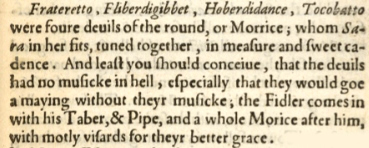 |
1604 'Friar Bacons Prophesie' alludes to the performance of the dance as a harvest rite for the bringing-in of the oats and rye, presumably at Lammas, or Lughnassa, in early August.
"...The Taber and the Pipe,
The bagpipe and the Crowde,
When oates and rye were ripe,
Began to be alowde.
But till the harvest all was in,
The Moris Dance did not begin..." (84)
Bemoaning the degeneration of custom over time, the author later remarks that now,
." . . Moris dances doe begin
Before the harvest halfe be in..." (85) |
1604 court notes: Cambridgeshire, Wilburton
“Iohannes Sutton. Notatur that he did abuse and prophane the Sabboth daie, by playing the Minstrell
for certaine dancers of the morrice, being of the parishe of Thetforde, who daunced from towne to
towne & so to wilberton ffeast, as well in service tyme as otherwise, to the displeasure of Almightie
God, & the offence of many.”
John Sutton “ appeared, and admitted that the article charged against him was true wherefore the lord (judge) dismissed the same Sutton from his office with a solemn warning.”
Diocesan Court Proceedings f 79v 28 March |
1613 comedy by Beaumont and Fletcher, entitled the' Knight of the Burning Pestle':
"Wife. This will be brave, i'faith! George, shall not he dance the morris too,
for the credit of the Strand?"
Rafe, one of the characters, appears as Lord of the May :
" And, by the common-councell of my fellows in the Strand,
With gilded staff, and crossed skarfe, the May-Lord here I stand."
He adds " The Morrice rings while Hobby Horse Both foot it featously ;"
and, addressing the group of citizens assembled around him, " from the top of Conduit-head,"
he says in Act 4 Scene V:
" And lift aloft your velvet heads, and, slipping of your gowne,
With bells on legs, and napkins cleane unto your shoulders tide,
With scarfs and garters as you please, and hey for our town cry'd
March out and shew your willing minds by twenty and by twenty,
To Hoxton or to Newington, where ale and cakes are plenty.
And let it nere be said for shame, that we, the youths of London,
Lay thrumming of our caps at home, and left our custome undone.
Up then, I say, both young and old, both man and maid, a Maying,
With drums and guns that bounce aloude, and merry taber playing." |
1617 Morris dance is discussed in a play:
“Morrice-bels? And waste-coates, and napkins?... . So, now we want nothing but the Taborer wee talk't of:
but 'tis no matter, since he does not come, wee'll sing, and so make musike to our selves. ? [Enter an hobby horse
dancing the Morrice, and a Tabourer] Oh, here they are both...
[They dance three times, the hobby-horse over throwes them all againe, kisses Musica, and runnes away with the Tabourer]”
'Technogamia or The marriages of the arts: a comedie,' Holyday (1617) 46 editions published between 1618 and 1630 |
1618 play - Barten Holyday 'TECHNOGAMIA, or THE MARRIAGES OF THE ARTS'
The tabourer is a non-speaking part. The Tabourer enters with the Hobby horse for the Morris
entertainment performed by Musica and the four humor characters. |
 c1620 On the Thames at Richmond c1620 On the Thames at Richmond
a pipe and tabor player accompanies
a hobby horse and morris dancers. |
c 1620 in 'The puisne's walks about London'
the hero relates:
"...And when I came unto the route
Good Lord! I heard a tabor play
For so, God save me! A morrys-daunce ..." |
|
1621 play
'Witch of Edmonton', published 1658 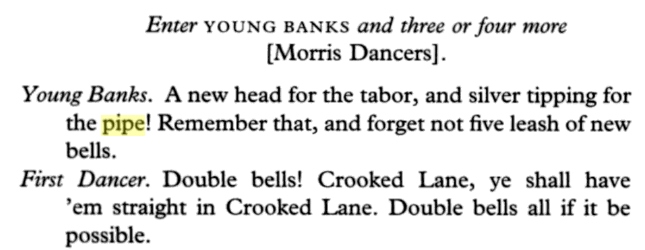 |


|
1634 poem 'Pasquil's Palinodia'  pages 14, 15 in 'ILLUSTRATIONS OF Old English Literature' . EDITED BY J. PAYNE COLLIER . VOL . I. LONDON : PRIVATELY PRINTED . 1866 pages 14, 15 in 'ILLUSTRATIONS OF Old English Literature' . EDITED BY J. PAYNE COLLIER . VOL . I. LONDON : PRIVATELY PRINTED . 1866 |
1646 A student of Christ Church and Captain of the Christ Church garrison wrote a description of a day out.
The garrison left Oxford and arranged to be met in Witney by morris dancers - a troop that included country fiddlers,
a taborer, a pair of bagpipes, a harper and a group of singers.
‘The King Found at Southwell, and the Oxford Gigg playd, and Sung at Witney Wakes: With the Masque shewed before divers Courtiers,
and Cavaliers, that went thither from Oxford, and severall Ketches and Songs at the said Wakes,’ by F. Loyd
[Ed the pamphlet is in the British Library but not currently available online] |
1652 Samuel Wikes, Tabbrer.
Ten morris dancers and a taborer were charged at the Staffordshire quarter sessions
with having danced the morris
at a church fair in spite of warnings by ministers of St Mary's
in Wolverhampton on Sunday July 1st:
'in contempt of several ministers that were
arbitrating a difference between two gentlemen in the bouse of Mr. Richard Francis'.
The dancers were all tailors. One of the dancers was taken:
'lying drunk in the minister's porch, that he could not
stand up, and the rest were little better'.
Staffs. Quarter Session Rolls. 1652. Translation No. 6. 4 Ch. II |
1660 King Charles II entered London on return from exile in Holland; at Blackheath:
“…a kind of rural triumph, expressed by the country swains, in a morrice dance
with the old music
of taber and pipe which was performed with all agility
and cheerfulness imaginable.”
The journey is described in a contemporary pamphlet 'England's Joy or a relation of the most remarkable
passages from his Majestry's Arrival at Dover to his entrance at White-Hall' (1660). |
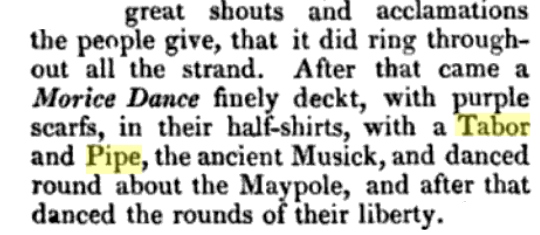 Hone's Everyday Book, May 1st 1661 Hone's Everyday Book, May 1st 1661 |
| about 1661 Chester Midsummer Show
“At the restoration of Charles II., the citizens of Chester replaced their pageant, and caused all things
to be made new, because the old models were broken.
..
. Six morris-dancers, with a pipe and tabret, had twenty shillings; ..."
Hone The Everyday Book 1826 June 23rd |
1661 
‘The History of Morris Dancing, 1458-1750’ by Forrest, John, 1999 |
17th century .” Dancers at Eaton Constantine in linen, scarfs, antic dress, and bells, danced round a maypole to
pipe and tabor on Sundays.”
‘The Morris Dance in Herefordshire, Shropshire and Worcestershire’ by E. C. Cawte
Journal of the English Folk Dance and Song Society, Vol. 9, No. 4 (Dec., 1963) |
17th century, in Hereford:
“eighteen persons, the fiddler, the taborer, the four whifiiers, and the twelve dancers in this morris”
page 144
“Old Hall of Hereford. ... the waits of three metropolitan cities make not more music than he can, with his pipe and tabor”
page. 139
“The wood of this old Hall's tabor should have been made a pail to carry water in, ....; but Hall, being wise,
because he was, even then, reasonably well stricken in years, saved it from going to the water, and converted it,
in those days, to a tabor. So that his tabor hath made bachelors and lasses dance round about the May-pole
threescore summers, one after another, in order, and is yet not worm-eaten.”
page 140
In 1609 a tract called " Old Meg of Herefordshire, for a Mayd Marian, and Hereford Toivnc for a Morris Daunce ;
or Twclve Morris Dauncers in Hereford- shire of Twclve Hundred Years Old." is dedicated :
" To that renowned Ox-leach, Old Hall, Taborer of Herefordshire, and to his most invincible, weather-beaten,
Nutbrowne Tabor, being alreadie old and sound, three-score ycarcs and upward.”
“Alas ! what do I see? Hold, Taborer ! stand, Hobby-horse ! Morris- dancers, lend us your hands !
Behold one of the nimble-legged old gallants is by chance fallen down,”
page 145
Temple says :
" There went about the country a set of morris-dancers, composed of ten men, who danced, a maid marian,
and a tabor and pipe." |
1696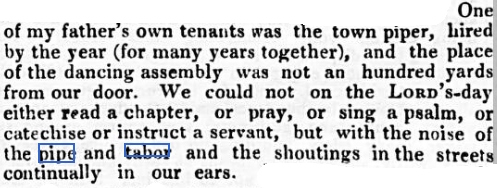  Quoted in Morning Herald (London) -
Thursday 07 September 1843 Quoted in Morning Herald (London) -
Thursday 07 September 1843 |
|
18th century pipe from Chipping Campden  |
1720’s - 'Dixton Harvesters', a painting
in Cheltenham Art Gallery showing how the harvest was gathered.
The pipe and tabor player accompanied all the different activities.
(
The painting has poor lighting and is high up on the wall so difficult to photograph [frances] ) |
 part of the painting part of the painting |
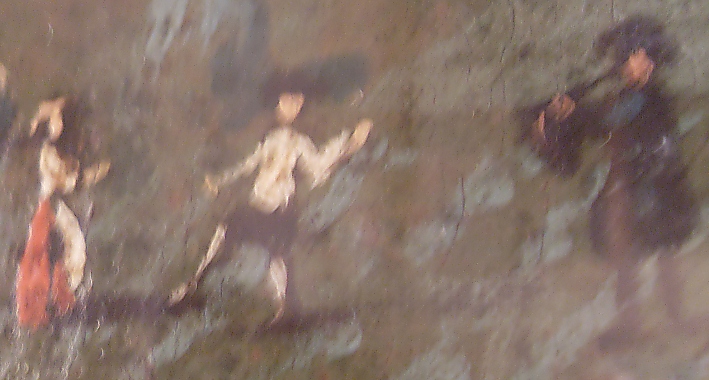 dancing dancing |
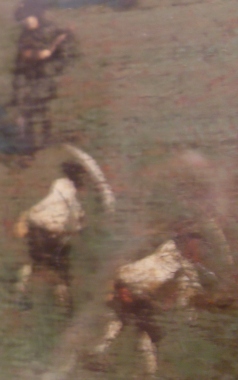 scything scything |
|
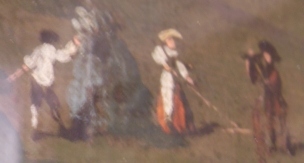 gathering hay gathering hay |
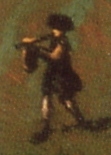 leading a line of workers leading a line of workers |
|
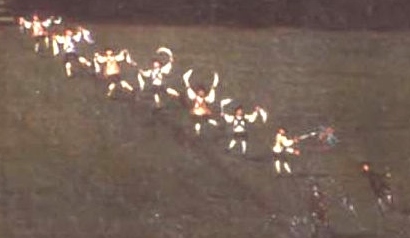 |
leading morris men
out of the picture |
|
| 1731 London
“…It is pleasant, just before the beginning of hay-harvest in the environs, to observe the monotony of some
long dull street" of dingy houses, broken by the simple music of the pipe and tabor, and the ringing of bells
on the legs of the morris dancers. It tells of the country and its delights to the dull ear of the Londoner, while,
moreover, there seems a patch of old-time merriment in the active but not mincing motions of the ruddy and
sun-born countrymen who thus endeavour to gain a few pence by the exhibition of their own peculiar pastimes
to those "pent up in populous city." They generally perform three (perhaps more) different dances, one with sticks,
the rattling of which, struck against one another, keeps time to the music ;-another with handkerchiefs, which are
gracefully waved in various directions ; and a third, in which the hands are clapped in unison with the pipe and tabor.
All are pleasing, when executed with precision….”
'Scraps from, a Note-Book' The Gentleman's Magazine |
1731 obituary The Gentleman's Magazine The Gentleman's Magazine |
| 1733, May 19th in the vicinity of Hempsted, Gloucestershire
" two Children were burnt in a terrible Manner at Hemftead near this City, one of which is since dead, and the other
lies dangerously ill: It is observable, that the affectionate Father was then attending a Company of Morrice Dancers
with his Tabot and Pipe, and when the News of this melancholy Accident was brought to him, he refused to return
home, saying, He would not lose his Whitfuntide."
Thomas Hill 1706-1739 |
Writers recorded seeing morris men and women dancing to the pipe and tabor in towns too:
"In Fleet strete then I heard a shoote :
putt off my hatt, and I made no stave,
And when I came unto the rowte,
Good Lord ! I heard a taber playe,
For so, God save mee ! a Morrys-daunce :
Oh ! ther was sport alone for mee,
in John Brand (1744-1806) |
 Rustic Sounds, and Other Studies in Literature and Natural History
By Sir Francis Darwin Rustic Sounds, and Other Studies in Literature and Natural History
By Sir Francis Darwin |
1770's
Gwilym Davies has researched the history of the pipe and tabor in Gloucestershire up to the present. He found
that the
pipe and
tabor were played in
Chipping Campden in the 1770's. James Warner (1737-1772) from the
town played for morris dancing. His possible 18th century
pipe has been given to the Gloucestershire Folk Museum
which, if it is his, is probably the oldest surviving
instrument known to have
been used for morris dancing. |
1772, June 8th
" Warner was an accomplice with Kelly in the murder of Richard Dyer. It seems that KELLY is a famous Morrice-dancer; and on Sunday morning before the fact was committed, he was teaching a set of fellows to dance. WARNER, used to play on the tabor and pipes to the dancers. It is to be hoped the Justices will suppress such nurseries of idleness and drunkenness as Morrice-dancings have generally proved."
Court records GLOUCESTER JOURNAL, 1772 |
|
|
| 1774 Oxfordshire
“…There were also the dancers of the Bedlam-morris. They did not wear bells, and were distinguished
by high peaked caps (such as are worn by clowns in pantomimes) adorned with ribbons. … A clown
and
a piper attended them….”
‘The Ancient English Morris Dance’ by Michael Heaney, 2023 |
1777 a play incorporated morris dances in the intervals between acts: 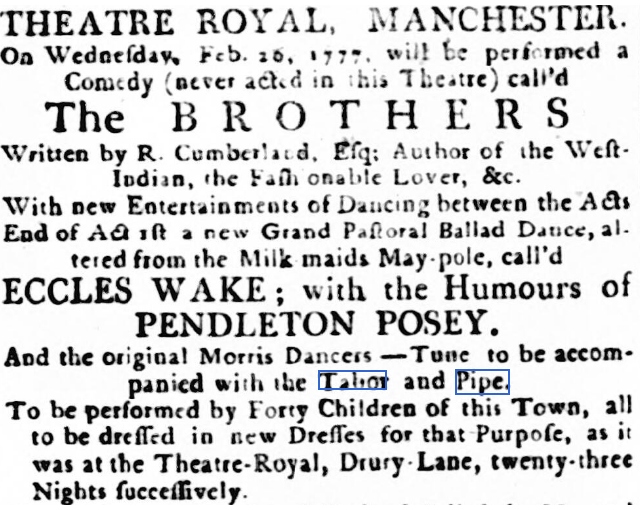 |
Leeds Intelligencer - Tuesday 22 May 1781
At the theatre in Leeds entertainments between plays included:
“Morris Dancing to be accompanied by a Tabor and Pipe”
also in 1782 in Derby at the New Theatre “Morris Dancing to be accompanied by a Tabor and Pipe” as part of the evening's
entertainments.
Derby Mercury - Thursday 28 February 1782 |
1783 Cheltenham Spa
“…Companies of these morrice dancers, attended by the jester, and tabor and pipe, go about the country
on Monday and Tuesday in Whitsun week, and collect a sum towards defraying the expences of the Yule….”
'Tour to Cheltenham Spa; or, Gloucestershire display'd. Containing, an account of Cheltenham ... The natural
history of the county of Gloucester,
the city of Gloucester' ..
by Moreau, Simeon; Royal College of Physicians of Edinburgh |
By the early 1800's writers were starting to mourn the gradual decline of folk traditions like the playing of
the pipe and tabor in the streets.
And by the middle of the nineteenth century fashions were changing and the pipe and tabor dropped out of use
for morris dancing.
Many old morris dancers when deprived of the whittle and dub's simple tune and steady
beat simply gave up. |
1805 Samuel Johnson ‘A dictionary of the English Language'
‘Maidmarian A kind of dance so called from a buffoon dressed like a man who plays tricks to the populace.
A set of morrice dancers danced a maidmarian with a tabor and pipe’ Temple |
morris dance remembered  'Something for Everybody' by John Timbs 1861 Page 68 'Something for Everybody' by John Timbs 1861 Page 68 |
1807
Died: "On Sunday se'nnight, Mr. James Nicholson, of York;
supposed in his day to be the best performer on the pipe and tabor in the kingdom."
Manchester Mercury - Tuesday 08 September 1807 |
1811, 19 January
Died "At Easton, near Winchester, aged 94 years,
Mr. John Bucksey, a well-known pipe and tabor player,
who has assisted in promoting the merry dance to at least
three generations of the gay and sprightly."
Jackson's Oxford Journal
1811, 14 January
better known " by the name of Old Bucksey the Fiddler; his usual instrument, however, was the pipe and tabor.
Few men, in his humble walk of life, were so well known to the fashionable and gay world. "
The Hampshire Telegraph and Sussex Chronicle
|
the pipe and tabor player, 'poor old Master Beechey, of Lew', played at Bampton early in the century.
Jackson's Oxford Journal, 29 May 1858 |
John Fathers (1789-1873) was born at Upper Heyford, and played for a number of morris sides, probably
in the vicinity of Marston.
“He Played the Whittle and Dub for the different Morris round about – he died about 20 years ago at the age
of 80 and the wife of his son …. told me that she gave her Children the Whittle and Dub to Play with and she
remembers them Breaking them to Pieces.” |
John Timbs (1801 –1875) wrote of when he was a school-boy: mentioned in the Hertford Mercury and Reformer - Saturday 08 June 1889 mentioned in the Hertford Mercury and Reformer - Saturday 08 June 1889
|
1820 story  ‘The Literary Gazette’ ‘The Literary Gazette’ |
As a child Sir George Gilbert Scott (1811-1878) lived in Gawcot village, Buckinghamshire. In 1827 he moved
to London to become an architect associated with the design, building and renovation of churches, cathedrals and workhouses. Writing about his childhood:
"The Morris dancers were young men perhaps about a dozen in number. ...In their hands were short 'white wands' & they danced to the 'pipe and tabour'... I well remember My intense admiration of their skill.
The noise of the dozen wands keeping time with the tabour and of the jingling bells also roughly following the tune added to the lively antics"
(source: London, British Architectural Library, Manuscripts and Archives Collection, Sir George Gilbert Scott Papers, Sc GGS/3, notebook 1, 'Personal & Professional Recollections', f. 27, written 22 January 1864; published in Recollections of Nineteenth century Buckinghamshire, p.18)
|
at Bampton in the Cotswolds:
" Thomas Radband (1776-1854), had played them around the turn of the eighteenth century;
the pipe and tabor player, 'poor old Master Beechey, of Lew', who had played at Bampton early in the century."
(source: Article MT051, Musical Traditions)
|
at Spelsbury in Oxfordshire:
"Spelsbury Morris (around 1820's) was a set of women Morris Dancers who used to dance on Whit Monday. They were mostly farmers daughters, girls of 18-20, and were under the escort of a man who looked after them. ..... With them went a clown or "squire" with bladders or cow's tail and a man playing the pipe and tabour."
(source: John Corbett, 88, of Spelsbury Aug 1894, The Morris Ring Archive - Cecil Sharp Folk Dance Notes)
|
1826, Goswell Road, London; a correspondent, writing to the "Every Day Book," describes what was evidently
the same company as being in Rosoman Street, Clerkenwell, in June of the same year :
" They consisted of eight young men, six of whom were dancers, the seventh played the pipe and tabor ... ”
Morris dancing still went on in the countryside and the dancers came to the towns once a year:
A letter from a reader to the editor of The Every-Day Book (1838):
“In June, 1826, 1 observed a company of these 'bold peasantry, the country's pride' in Rosoman-Street, Clerkenwell...
it was the third year of their pilgrimage; that they had never disputed on the road, and were welcomed home by their
sweethearts and friends...” |
1826 historical novel:
"Were you now, in your bodily self, to light suddenly on a Maypole, with all the blithe morris-dancers prancing around it
to the merry pipe and tabor, with bells jingling, ribands fluttering, lads frisking and laughing, lasses leaping"
Woodstock OR THE CAVALIER. A TALE OF THE YEAR 1651, by Sir Walter Scott
|
1829 Duchess of St Albans wedding anniversary garden fete:
 Morning Chronicle - Monday 22 June 1829 Morning Chronicle - Monday 22 June 1829
|
1829 in Gloucester: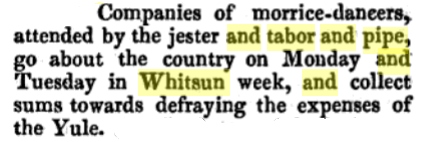 The Mirror of Literature, Amusement, and Instruction Volume 13 Page 357 The Mirror of Literature, Amusement, and Instruction Volume 13 Page 357 |
Gutch writing in 1847says that, a few years before, he witnessed
" a numerous retinue of morris-dancers, remarkably well habited, skilfully performing
their evolutions to the tune of a tabor and pipe in the streets of Oxford University"
in a chapter called The Morris Dancers:
p 143 "These eighteen persons, the fiddlers, the taborer, the wifflers" (?)
p145 "hold taborer"
quoted in: 'Rush-Bearing : An Account of the Old Custom of Strewing Rushes, Carrying Rushes to Church;
The Rushcart; Garlands in Churches; Morris Dancers; The Wakes; The Rush'. by Alfred Burton
|
| |
for other types of dance see :
dance of death
18th century dance
Regency dance
folk customs
moresca
|
| |



 Hone's Everyday Book, May 1st 1661
Hone's Everyday Book, May 1st 1661 

 part of the painting
part of the painting  Rustic Sounds, and Other Studies in Literature and Natural History
By Sir Francis Darwin
Rustic Sounds, and Other Studies in Literature and Natural History
By Sir Francis Darwin
 'Something for Everybody' by John Timbs 1861 Page 68
'Something for Everybody' by John Timbs 1861 Page 68 The Mirror of Literature, Amusement, and Instruction Volume 13 Page 357
The Mirror of Literature, Amusement, and Instruction Volume 13 Page 357














